
KARACHI: The current account deficit, which is one of Pakistan’s biggest economic challenges, continued to widen in July, indicating further pressure on the rupee and foreign currency reserves.
The deficit increased 14% to $2.20 billion in July, the first month of the current fiscal year 2018-19, compared to $1.93 billion in the same month last year, the State Bank of Pakistan (SBP) reported on Monday.
Pakistan’s trade deficit stands at $3.19b
“Rupee depreciation has not yet made a meaningful impact. It means the correction in the rupee’s value will continue,” former finance minister Dr Salman Shah predicted while talking to The Express Tribune.
Earlier, the central bank had let the rupee depreciate by a massive 18% to Rs124.24 to the US dollar since December 2017.
The move was aimed at boosting sluggish exports and curbing excessive imports with the objective of narrowing down the trade deficit, which was the major driving force behind the expanding current account deficit.
Besides, the previous government of Pakistan Muslim League-Nawaz (PML-N) extended a Rs180-billion export package and imposed regulatory duty on import of over 300 goods.
So far, the rupee depreciation has largely failed to deliver desired results and neither is it believed to do so in future as most of the imports comprise raw material, which are primarily meant for export goods, according to JS Global Chief Commercial Officer Khurram Schehzad.
The ex-finance minister’s anticipation of further rupee depreciation matched with the suggestion of former caretaker finance minister Dr Shamshad Akhtar to the new government that it would have to let the rupee weaken by another 8% in the current fiscal year in order to fix the faltering economy.
The rupee’s value would remain uncertain until the foreign currency reserves showed a healthy growth through corrective measures as well as short- and long-term borrowing, Shah said.
“The government will have to balance its strategy to deal with the challenges in a way that economic growth is not compromised despite corrective measures like cutting the fiscal and current account deficits,” he said.
Shah suggested that the government should ensure short-term borrowing from friendly countries like China and others. Later, it needs to enter into discussion with the International Monetary Fund (IMF) for long-term borrowing to create confidence in the economy.
The government’s strategy must result in strengthening of the rupee and stabilisation of foreign currency reserves in the long run. “This will not be possible without solid planning and implementation,” he said.
The central bank reported the trade deficit of goods expanded 26% to $3.55 billion in July 2018 compared to $2.82 billion in the same month last year.
Pakistan’s current account deficit peaks at $17.99b
Inclusive of trade in services, the trade deficit rose 23% to $4.05 billion in the month compared to $3.30 billion in July 2017.
In addition to this, foreign direct investment in the country dropped 45% to $128 million in July from $232 million in July 2017.
On the flip side, dollar inflows on account of worker remittances rose 25% to $1.93 billion compared to $1.54 billion in the corresponding month of previous year, the central bank said.
Published in The Express Tribune, August 21st, 2018.
Like Business on Facebook, follow @TribuneBiz on Twitter to stay informed and join in the conversation.






















































COMMENTS
Comments are moderated and generally will be posted if they are on-topic and not abusive.
For more information, please see our Comments FAQ